Related Research Articles
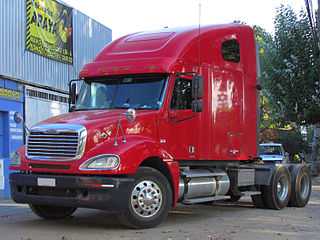
A semi-trailer truck, also known as a semitruck, is the combination of a tractor unit and one or more semi-trailers to carry freight. A semi-trailer attaches to the tractor with a type of hitch called a fifth-wheel.

Suspension is the system of tires, tire air, springs, shock absorbers and linkages that connects a vehicle to its wheels and allows relative motion between the two. Suspension systems must support both road holding/handling and ride quality, which are at odds with each other. The tuning of suspensions involves finding the right compromise. It is important for the suspension to keep the road wheel in contact with the road surface as much as possible, because all the road or ground forces acting on the vehicle do so through the contact patches of the tires. The suspension also protects the vehicle itself and any cargo or luggage from damage and wear. The design of front and rear suspension of a car may be different.
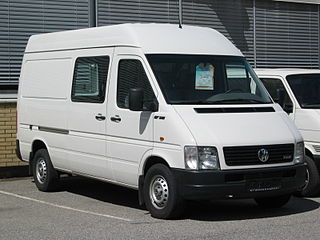
The Volkswagen Transporter LT is the largest light commercial panel van produced by Volkswagen from 1975 to 2006, before being replaced by the Crafter. Two generations were produced.

A transfer case is a part of the drivetrain of four-wheel-drive, all-wheel-drive, and other multiple powered axle vehicles. The transfer case transfers power from the transmission to the front and rear axles by means of drive shafts. It also synchronizes the difference between the rotation of the front and rear wheels, and may contain one or more sets of low range gears for off-road use.

The Ford Super Duty is a series of trucks manufactured by the Ford Motor Company. Introduced in 1998 for the 1999 model year, the F-Series Super Duty trucks marked the addition of a heavy-duty pickup to the Ford F-Series range with the new versions of the F-250, F-350, and F-450 trucks, while the previous 1987–1997 F-Super Duty chassis cabs were replaced by the F-450 chassis cab and F-550 Super Duty.
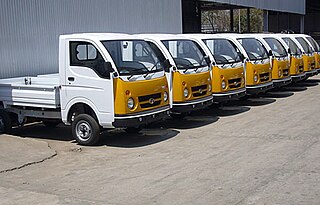
The Tata Ace is a mini truck launched in May 2005 by Tata Motors in India.
The Chevrolet Engineering Research Vehicle (CERV) is a series of Chevrolet experimental cars. Chevrolet Staff engineer, designer, and race car driver Zora Arkus-Duntov started development of the CERV I in 1959, and began work on the CERV II in 1963. Chevrolet chief engineer Don Runkle and Lotus' Tony Rudd discussed creating a new show car to demonstrate their engineering expertise in 1985; It would become the CERV III. Corvette chief engineer Dave Hill unveiled the CERV IV in 1993, a test vehicle for the 1997 C5 Corvette.
Fabrika automobila Priboj is a Serbian automotive manufacturer of military vehicles and with the headquarters in Priboj, Serbia.
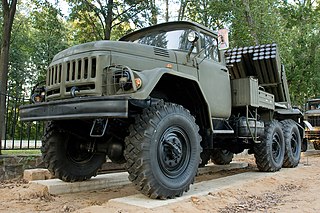
The ZIL-131 is a general purpose 3.5 tonne 6x6 army truck designed in the Soviet Union by ZIL. The basic model being a general cargo truck. Variants include a tractor-trailer truck, a dump truck, a fuel truck, and a 6x6 for towing a 4-wheeled powered trailer. The ZIL-131 also serves as a platform for the 9P138 rocket launcher, a 30-tube variant of the BM-21 "Grad".
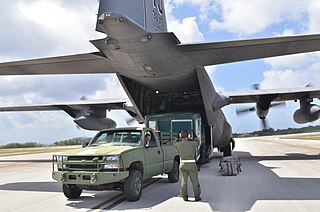
The Commercial Utility Cargo Vehicle (CUCV) is a vehicle program instituted to provide the United States military with light utility vehicles based on civilian trucks.

HydroGen3 was an Opel hydrogen fuel cell concept vehicle used for testing in 2006. HydroGen3's 400-kilometer (250 mi) driving range is the highest of any fuel cell vehicle approved for public roads in Japan. The five seater front-wheel driven prototype is based on the Opel Zafira compact MPV.

The FAP 1118 is a series of 4x4 military trucks manufactured by Fabrika automobila Priboj (FAP), based on the Mercedes-Benz NG series. The FAP 1118 is intended to replace the TAM 110 series of military trucks in the Serbian Armed Forces.

FAP 2026 is a general purpose off-road lorry made by Serbian vehicle manufacturer Fabrika automobila Priboj (FAP). The six-wheel drive lorry is designed for transport of personnel, weapons and material up to 6 tons of total weight, as for traction of weapons and trailer up to 7.2 tons of weight for the needs of the Yugoslav People's Army.
The Dana/Spicer Model 70 is an automotive axle manufactured by Dana Holding Corporation and has been used in OEM heavy duty applications by Chevrolet, Dodge, and Ford. It can be identified by its straight axle tubes, 10 bolt asymmetrical cover, and a "70" cast in to the housing and is visually similar to the Dana 60. The majority of the Dana 70s are rear axles, however Dana 70 front axles do exist. Both front and rear axle variations were first offered in 1957. The Dana 70 is generally regarded to have more strength than a Dana 60 but not as much as a Dana 80. Gross axle weight ratings are often lowered by the vehicle manufacturer for safety and tire reasons.

The Willys MC, formally the 1⁄4-Ton, 4 x 4, Utility Truck M38, or the G‑740 by its U.S. Army Standard Nomenclature supply catalog designation, is a quarter-ton four-wheel drive military light utility vehicle made by Willys between 1949 and 1952. It replaced, and succeeded the World War II Willys MB and Ford GPW models, with a total production of some 50,000 units — less than one tenth the number of WWII models built. Unlike during WWII, Ford was no longer involved in the production.

Marussia Motors was a Russian sports car company founded in 2007. It was the first Russian company to produce a supercar. It designed, and manufactured prototypes of both the B1 and the B2 sport cars. Marussia was led by former motor racer Nikolai Fomenko. The Marussia B1 was launched in December 2008 in the new Manege hall in Moscow.

Self-propelled howitzer 122mm SORA is a Serbian 122mm self-propelled howitzer developed by the Military Technical Institute (MTI) for the Serbian army. Self-propelled howitzer SORA features whole upper part of 122mm howitzer D-30J mounted on the rear end of modified FAP 2026 BS/AV truck chassis. Main functions of the weapon system, such as navigation, gun lying, loading of ammunition and deployment, are fully automatic.

The LX and FX are ranges of purpose-designed tactical military trucks manufactured by what is now Rheinmetall MAN Military Vehicles (RMMV). They were replaced in production by the HX range. There was also an MX range, but this was only produced in very small numbers for the German Navy.

The Goliath GD750 was a three-wheeler pickup truck built by the Goliath division of the Borgward Group in Bremen from April 1949 to 1955 in various body variants. In the early 1950s, low-cost vans were popular with small craft businesses. In 1949, the purchase price for flatbed variant was DM 3600. In total, 30,093 units of the GD750 were built. In 1950 and 1951, a huge quantity of vehicles were built, 8468 and 7136 units respectively. The number 750 in the type designation indicated the possible payload of 750 kg.
Vehicle weight is a measurement of wheeled motor vehicles; either an actual measured weight of the vehicle under defined conditions or a gross weight rating for its weight carrying capacity.